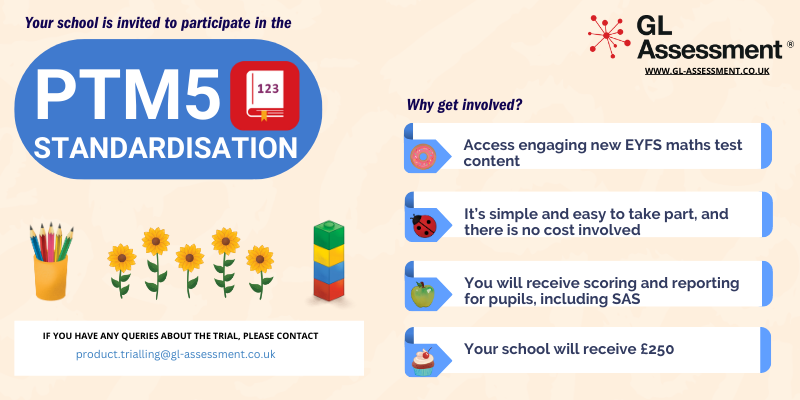PTM5 2023 Standardisation

Join the PTM5 Standardisation
Please contact [email protected] with any queries.
In May 2023 we trialled new questions for our Progress Test in Maths Level 5 to bring it in line with changes to the EYFS. This is a paper assessment for children aged 4 – 5 years (Reception) that tests key aspects of maths appropriate to the age of the pupils, such as subitising, number bonds, comparing different quantities and more.
Following the trial, we are ready to standardise* a final version of the new question paper between Monday 3rd July and Wednesday 19th July.
Why take part?
- Your school will gain priority access to engaging new EYFS maths test content
- You will receive data for each pupil, including SAS** (standard age scores) using UK norms that will help you identify gaps in learning and see their progress in relation to their peers
- It’s simple and easy to take part, and there is no cost involved
- Your school will receive £250 on return of booklets completed within the trial window.
What does the trial involve?
- Register to take part here.
- Receive your printed booklets by courier along with teacher guidance and instructions.
- Upload a pupil data template for scoring and reporting purposes.
- Administer the tests at any time during the trialling window.
- Book your free and secure return of the booklets.
- Booklets will be marked and data analysed.
- You will receive pupil reports in the academic year commencing Autumn 2023.
Please note: your pupil data will be used to calculate UK norms for PTM5 but will not be shared externally outside of GL.
About PTM5
The PTM5 assessment has no set time limit but should take around 40 minutes to complete. All instructions and questions are read out by the teacher/administrator, and the pupils write down answers in their test booklet.
For information about our current live Progress Test series click here.
What is Standardisation?
*What is standardisation?
Standardisation involves a large sample of students of varying ability sitting the same assessment in a ‘standard’ way, in the same conditions with the same instructions. This creates ‘norms’ based on a representative sample which can then be used to compare a pupil’s score to those of similar students their age.
**What is a Standard Age Score (SAS)?
SAS is based on the student’s raw score which has been adjusted for age and placed on a scale that makes a comparison with a nationally representative sample of students of the same age across the UK. The average score is 100. The SAS is key to benchmarking and tracking progress and is the fairest way to compare the performance of different students within a year group or across year groups.
Was this useful?
Our priority is to ensure you have the information you need to get the best from our products, and would like to know if this page helped you find what you needed?

